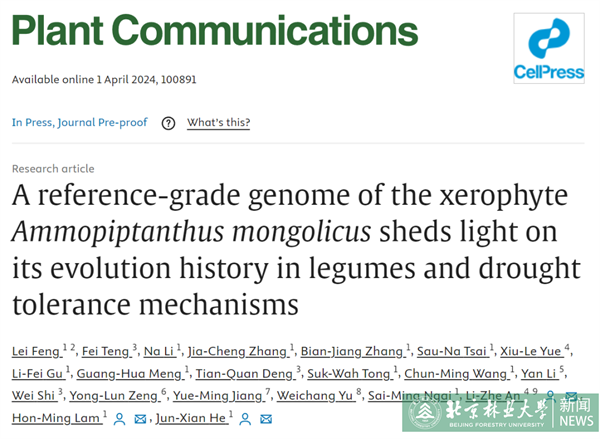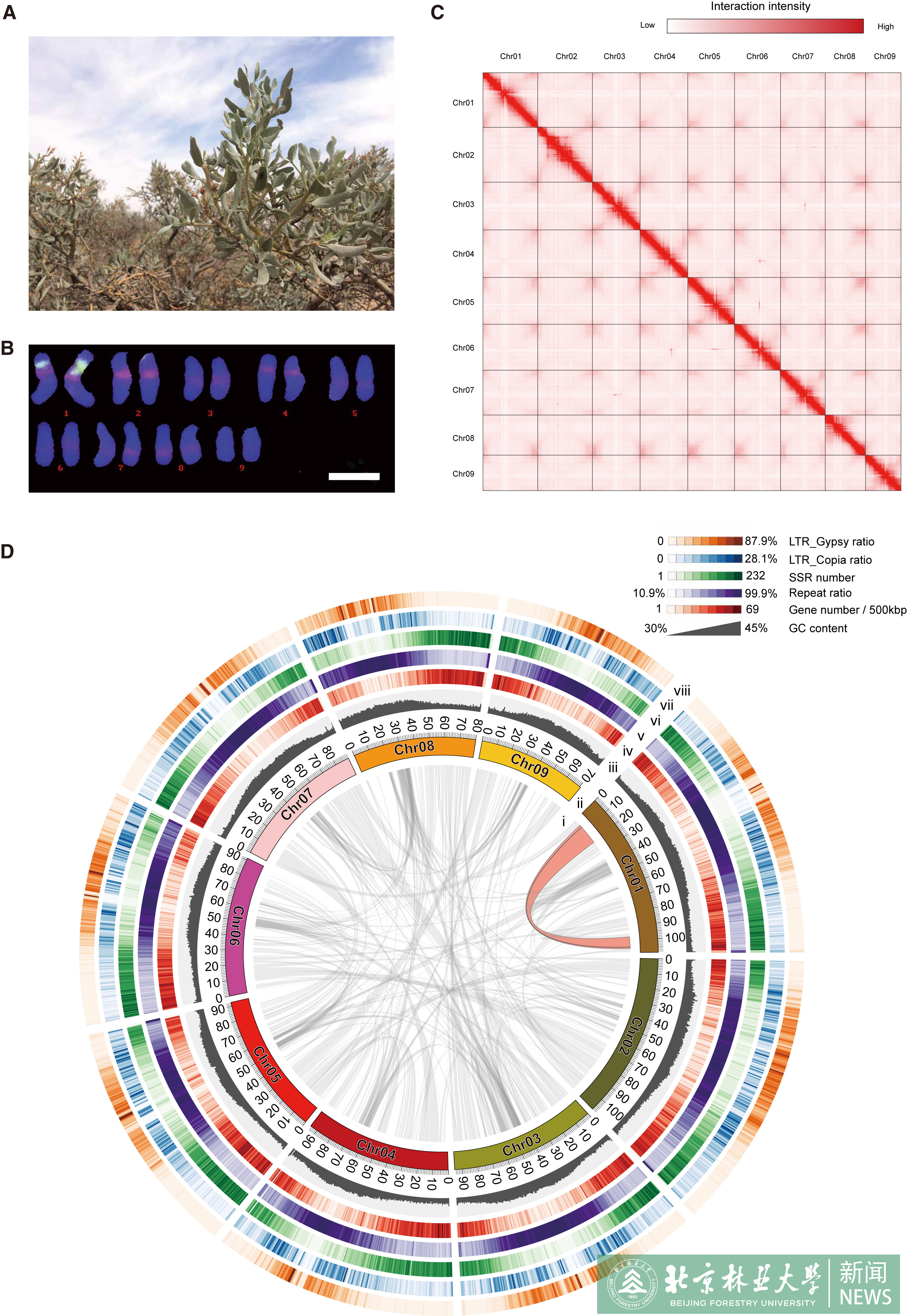Latest news
Recently, a research team led by Professor An Li Zhe from our university, in partnership with Professor He Junxian and Professor Lin Hanming from the Chinese University of Hong Kong, has published a significant study in Plant Communications. Entitled "A reference-grade genome of the xerophyte Ammopiptanthus mongolicus sheds light on its evolution history in legumes and drought tolerance mechanisms," the paper presents groundbreaking work using cutting-edge genome sequencing technology to assemble a chromosome-level reference genome for Ammopiptanthus mongolicus. The researchers have meticulously annotated the genome sequence, delved into its evolutionary traits, and unraveled the mechanisms underlying its remarkable drought resistance.

Plants that grow in extreme environments represent unique sources of stress-resistance genes and mechanisms. Ammopiptanthus mongolicus (Leguminosae) is a xerophytic evergreen broadleaf shrub native to semi-arid and desert regions; however, its drought-tolerance mechanisms remain poorly understood. Here, we report the assembly of a reference-grade genome for A. mongolicus, describe its evolutionary history within the legume family, and examine its drought-tolerance mechanisms. The assembled genome is 843.07 Mb in length, with 98.7% of the sequences successfully anchored to the nine chromosomes of A. mongolicus. The genome is predicted to contain 47 611 protein-coding genes, and 70.71% of the genome is composed of repetitive sequences; these are dominated by transposable elements, particularly long-terminal-repeat retrotransposons. Evolutionary analyses revealed two whole-genome duplication (WGD) events at 130 and 58 million years ago (mya) that are shared by the genus Ammopiptanthus and other legumes, but no species-specific WGDs were found within this genus. Ancestral genome reconstruction revealed that the A. mongolicus genome has undergone fewer rearrangements than other genomes in the legume family, confirming its status as a “relict plant”. Transcriptomic analyses demonstrated that genes involved in cuticular wax biosynthesis and transport are highly expressed, both under normal conditions and in response to polyethylene glycol-induced dehydration. Significant induction of genes related to ethylene biosynthesis and signaling was also observed in leaves under dehydration stress, suggesting that enhanced ethylene response and formation of thick waxy cuticles are two major mechanisms of drought tolerance in A. mongolicus. Ectopic expression of AmERF2, an ethylene response factor unique to A. mongolicus, can markedly increase the drought tolerance of transgenic Arabidopsis thaliana plants, demonstrating the potential for application of A. mongolicus genes in crop improvement.

Dr. Feng Lei from the School of Life Sciences at the Chinese University of Hong Kong, who is currently affiliated with the School of Life Sciences at South China Normal University is the first author of the paper. Professors An Li Zhe, He Junxian, and Lin Hanming are the co-corresponding authors. The collaborative research also included contributions from Teng Fei of BGI, Associate Professor Yue Xiule of the School of Life Sciences at Lanzhou University, Professor Yu Weichang of Shenzhen University, researchers Jiang Yueming and Zeng Yonglun from the South China Botanical Garden of the Chinese Academy of Sciences, and Professor Ni Shiming from the School of Life Sciences at the Chinese University of Hong Kong.
The authors extend their gratitude to Mr. Zhiyuan Li and Mr. Lingyuan Zeng for their assistance in the collection of A. mongolicus and A. nanus seeds in Inner Mongolia. They also acknowledge Mr. Aisi Fu and Ms. Qiong Ding of the Wuhan Institute of Biotechnology, China, for their support during the preliminary phases of PacBio sequencing. The appreciation is extended to Mr. Weijian Huang and Mr. Wanli Liang from Beijing Berry Genomics Co. Ltd. for their help with genome annotation. Special thanks are given to Prof. Caiji Gao from South China Normal University for providing laboratory resources and valuable suggestions for the project. The manuscript was copy-edited by Ms. Jee-Yan Chu.
This work was supported by the National Natural Science Foundation of China (NSFC) (no. 91125027); GRF grants (CUHK codes 14148916 and 14104521); AoE grants (AoE/M-05/12 and AoE/M-403/16) from the Research Grants Council (RGC) of Hong Kong; the NSFC-RGC Joint Scheme (N_CUHK452/17); the National Key Research and Development Program, Key Innovative and Collaborative Science and Technology Scheme for Hong Kong, Macau, and Taiwan (2017YFE0191100); direct grants from the Chinese University of Hong Kong; and the China Postdoctoral Science Foundation (2023M741234).
Paper link: https://doi.org/10.1016/j.xplc.2024.100891
Written by Gou Yue
Translated and edited by Song He
Reviewed by Yu Yangyang












